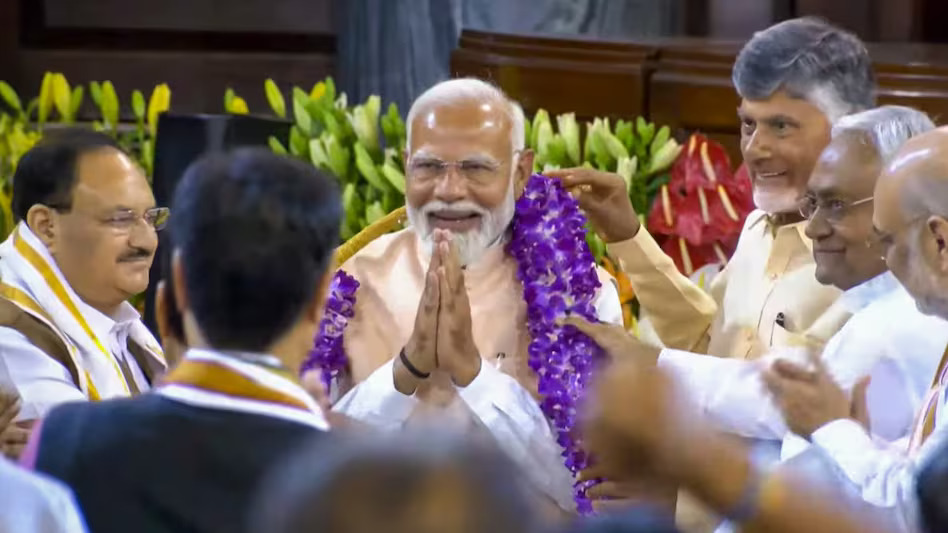It is reasonable to expect that far from slowing down, reforms will be speeded up.
By 105 seats, the NDA was short of the ambitious goal of 400 Lok Sabha seats in 2024 that the BJP had set for itself. While 295 seats fall well short of that mark, the NDA has a comfortable majority, in which the BJP itself has around three-fourths of the seats. While the I.N.D.I Alliance had in the polls come within striking distance of power, it remains a collection of political parties, several of which are bitterly in opposition at the state level.
The Congress Party has won almost double the Lok Sabha seats the party won in 2019. It breached the three-figure mark once an independent MP joined it. Given the mathematics, it is more likely that the Opposition alliance will shrink in numbers over the coming period than the ruling NDA, which has the advantage of having as its leader Narendra Modi, who has unanimously secured the support of every MP in the NDA for a third term in office as Prime Minister. This is a feat achieved in the past only by Mahatma Gandhi’s choice as the first Prime Minister of the Republic of India, Jawaharlal Nehru. The foundation for what may be described as India 1.0 was set in place by Prime Minister Nehru. Since taking office in 2014, Prime Minister Modi has transformed India on a scale sufficient to lay the foundation for India 2.0. In other words, a country geared towards the 21st century and its unique challenges and opportunities. After Nehru, not even Indira Gandhi was able to secure three consecutive terms in office, and except for Vajpayee, who was sworn in twice, no Prime Minister has had more than a single term.
Once sworn in as Prime Minister for the third time, Modi will go beyond the Vajpayee two-term record and enter a pantheon occupied until now only by Nehru. Whether India will have a Prime Minister who has won four terms will be answered in 2019, when the next Lok Sabha polls is due. There is a lot of chatter as to how long the present government will last. Some say three years, others less. In reality, the odds are that Modi 3.0 will continue uninterruptedly until the 2029 Lok Sabha polls fall due. Given the unpredictability and complexity of a national parliamentary
Apart from forecasting that the newly constituted Union Government will leave office before its full term of five years, several doomsayers who have been vociferous since June 4 have claimed that the reformist thrust of the Modi government will get diluted. In fact, it is likely to be accelerated. Only reforms can ensure that Modi 3.0 wins over enough voters to ensure another term in office. The BJP, TDP and JDU will want to ensure that each gets a significantly larger number of seats in 2029 than they won in the just concluded Lok Sabha polls. Among the alliance partners, the TDP under Chandrababu Naidu devoted several years to fashion an ambitious agenda for governance, should the people of Andhra Pradesh give Chandrababu Naidu another term as Chief Minister. The incoming AP CM is determined to chisel in stone his already impressive credentials as a reformer. It was CM Naidu who transformed Hyderabad into Cyberabad, a gift that the BRS in the past and the Congress subsequently are getting the benefit of, in terms of higher taxes, exactly the way Bengaluru so substantially adds to the Karnataka revenue stream and Mumbai to Maharashtra.
Determined to oppose any project championed by his nemesis, outgoing Chief Minister Jagan Mohan Reddy abandoned his predecessor’s plan to build a state capital that the people of Andhra Pradesh can be proud of, Amravati. Now that Naidu is back, that ambitious project will once again be restarted, and this time completed. Revanth Reddy, the affable, accessible Chief Minister of Telangana, had better watch out. As Andhra Pradesh CM, Chandrababu Naidu is likely to attract investment on an even larger scale than he succeeded in doing with Hyderabad, now the capital of Telangana. Not just Hyderabad but other state capitals in the South such as Chennai and Bengaluru will feel the effects of the revamp plan for Andhra Pradesh that Naidu has been working on for several years. In Bihar, the JDU needs to to accept the fact that the 21st century needs a Naya Soch, and that antiquated ideas that belong to the 20th century or even earlier are not what the youth of Bihar in particular seek. Across the world, people from Bihar are among the most successful expatriates in the countries they have settled in. During 2024-29, the JDU needs to learn from the success of Biharis outside Bihar and make sure that in Bihar too, talented daughters and sons of the state can shine in the way they do elsewhere, especially abroad.
In AP, Bihar and in every other state, reforms geared towards success in the 21st century are essential, and in Prime Minister Narendra Modi, they have a Head of Government who favours such reforms. A government is there to serve the people and it is not the people who should serve the government. Such a vision is what has been indicated by the new name chosen by Modi of the road where the Prime Minister officially resides, Lok Kalyan Marg. Judging by the quality of the reformists within the NDA, it is reasonable to expect that far from slowing down, reforms will be speeded up. A devolution of authority to lower levels and simplified regulatory systems that is favoured by the Prime Minister will accelerate in the coming years, creating a situation where the entire country gains from India’s climb to being the third largest economy by the time the next Lok Sabha elections take place.

